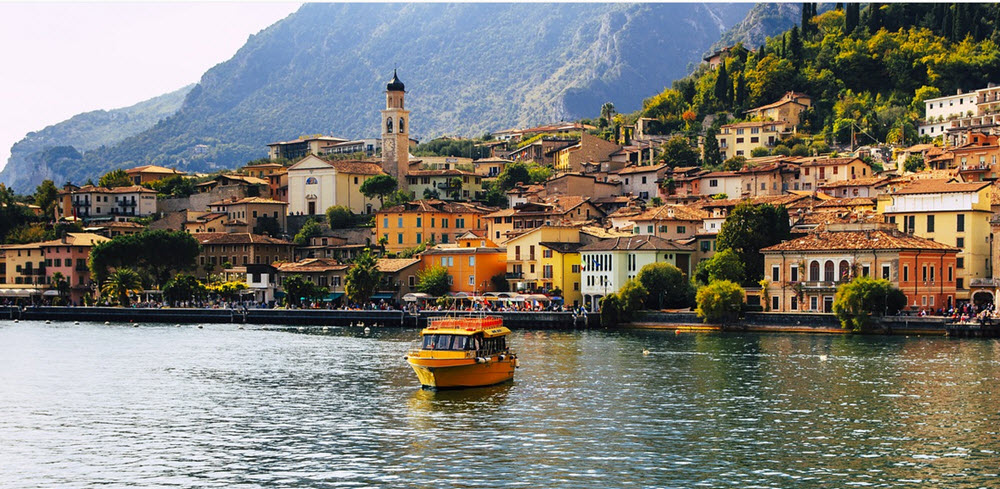Italy is divided into 20 administrative regions and the one that’s home to Lake Como is called Lombardia in Italian and Lumbardia in the local Lombard language. In English, we say Lombardy.
With a population of around 10 million people, Lombardy is one of the most populous of the 20 Italian regions despite not being one of the largest. Roughly 7.5 million people live within the Milan Metropolitan Area, which extends from Lombardy and into eastern Piedmont. Milan is the second-largest city in Italy; only Rome is home to more people.
Of course, the hustle and bustle of Milan feels very distant once you leave the urban area behind and head for the beautiful Lake Como countryside. For a very long time, Lake Como has been a refuge for wealthy Milanese families wishing to get away from big city life and enjoy the summer season in the countryside.

The provinces
Lombardy is divided into eleven provinces + the metropolitan city of Milan.
Here are the eleven provinces:
| Province | Area (km²) | Approximate population size |
| Province of Brescia | 4,784 | 1,25 million |
| Province of Bergamo | 2,723 | 1,1 million |
| Province of Varese | 1,211 | 890 000 |
| Province of Monza and Brianza | 405 | 865 000 |
| Province of Como | 1,288 | 600 000 |
| Province of Pavia | 2,965 | 550 000 |
| Province of Mantua | 2,339 | 415 000 |
| Province of Cremona | 1,772 | 360 000 |
| Province of Lecco | 816 | 340 000 |
| Province of Lodi | 782 | 230 000 |
| Province of Sondrio | 3,212 | 180 000 |
Geography of Lombardy
Lombardy is a varied region with everything from tall alps to rolling hills and flat plains. Lombardy is also rich in both rivers and lakes, including the larger River Po which marks Lombardy’s border for over 200 km in the south. Examples of rivers and streams hat contribute their water to River Po are Ticino, Olona, Lambro, Adda, Oglio and Mincio. The River Ricino comes in from Switzerland and joins the River Po near Pavia in southwestern Lombardy.
The northern highlands of Lombardy is sometimes referred to as Italy’s lake district – and all of the lakes here are of glacial origin. From west to east, these lakes are Maggiore, Lugano, Como, Iseo, Idro, and Garda. Both Lake Maggiore and Lake Lugano are partly in Switzerland.
Economy
The economy of Lombardy accounts for approximately one fifth of the nations GDP. Data from 2013 show that GPD per capita in Lombardy was above €33,000. This is considerably more than the nation’s average of less than €25,800.
Lombardy can be broadly divided into three areas:
- Greater MilanIn the this metropolitan area, roughly two thirds of all jobs are found in the service sector.
- The industrial provincesIn the wider Lake Como area, the provinces of Como, Lecco, Varese, Monza and Brianza, Bergamo, and Brescia are characterised by a high degree of industrialisation, although Bergamo and Brescia – both located in the plains – also have a thriving agricultural sector.
- The bread basketIn the provinces of Sondrio, Pavia, Cremona, Mantova and Lodi, the agricultural sector dominates the job market, although a lot of people also work in the service sector.
The lower plains of Lombardy grow chiefly crops used to feed livestock, plus substantial amounts of rice, wheat, corn (maize) and sugar beets. In the higher plains, there is a large production of fruits and vegetables, as well as mulberries. If we venture even higher up and into pre-alpine and alpine environments, we find plenty of wine producers.
In the 1980s, Lombardy shifted into having a fairly large service industry sector, which proved important as many traditional factory jobs moved from Italy to other parts of the world. In particular, the growth of innovative services, as well as companies in the banking and financial sector, have proven important to the sustained well-being of the Lombardy economy. Still, a considerable amount of production factories are still In Lombardy, which is now the main industrial area of Italy.
